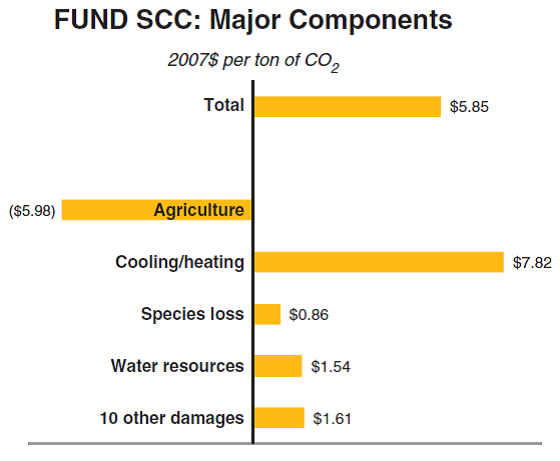The Lomborg man behind the IPCC mutiny
Bjorn Lomborg has a peculiar habit of invoking the entire economics profession and its body of work as being in support of his proposition that the globe do nothing to reduce emissions other than undertake research into low emission technologies and geo-engineering (direct human manipulation of the weather).
As an example, one of Lomborg’s initiatives was a world problem-prioritisation exercise known as the Copenhagen Consensus. On the website section focused on climate change, it boldly proclaims, “experts in climate economics examine the best ways to reduce suffering from global warming”.
But when Lomborg says that “economists” believe the benefits of reducing emissions aren’t worth the costs, what he should say is “Richard Tol believes.”.
If you look at Bjorn Lomborg’s body of work over the last few years you’ll see Tol is the one economist who consistently turns up as the lynchpin underlying Lomborg’s claims.
Tol has largely been in the background of public discourse with Lomborg as the media frontman. But he has grabbed newspaper headlines in recent weeks for publicly withdrawing his name from the IPCC’s Summary for Policy Makers from part two (impacts) of its Fifth Assessment Report. According to Tol, the Summary for Policy Makers was too alarmist and unrepresentative of the underlying IPCC chapters, something other IPCC authors strongly dispute.
Given these events Climate Spectator felt it worthwhile to more closely examine Richard Tol’s work and how it has been used. In addition to this article we’ve run two others today that highlight concerns surrounding Tol’s work.
Love at first citation
When Lomborg undertook his first Copenhagen Consensus exercise in 2008 he commissioned four economists to undertake a cost-benefit analysis of alternative approaches to addressing global warming (carbon price, adaptation and investing in R&D) – Gary Yohe, Richard G. Richels, Geoffrey Blanford and Tol.
That didn’t work out so well for Lomborg because Yohe wrote a public letter stating, “Lomborg is misrepresenting our findings thanks to a highly selective memory”. According to Yohe, while there were some benefits to developed countries from modest climate change (up to 2 degrees), Lomborg was suggesting this was the case for warming up to 4 degrees, which was a “deliberate distortion of our conclusions”.
So the next time Lomborg ran the exercise in 2009 he used Tol alone to prepare the cost-benefit analysis.
Tol found that the impacts of climate change are so minor that all that’s worth doing is imposing a $5 carbon tax. Also, in Lomborg’s book released last year, How Much have Global Problems Cost the World?, no prizes for guessing who the economist was that wrote the chapter on Climate Change.
Knowing the price of everything, but the value?
Now it should be acknowledged that Richard Tol comes with impressive credentials. He has been a lead author or contributing author on not just the latest IPCC Assessment Report but also ones prior to that.
Professor Tol has built his reputation through developing one of just a handful of what are known as integrated assessment models (his is called FUND). These complicated computer models attempt to estimate how a given level of global warming translates into a single dollar figure.
Sometimes this is straightforward. So, as an example, many Europeans will save money on their heating bills as a result of global warming – this could save them a few hundred dollars a year, so this is put this into the model.
Now at the same time many sub-Saharan Africans will lose their lives because their crops are already being grown close to bearable temperature thresholds. How much are these lives worth? Well, the average sub-Saharan African might struggle to earn a few hundred dollars a year so let’s use that as the dollar proxy for the value of their lost lives – a pretty straightforward dollar estimate.
The end result? The African’s lives aren’t worth saving because the Europeans save more on their heating bills than the dead Africans earn.
There are a range of other inescapable value judgements and omissions hidden behind these integrated assessment models' seemingly precise and scientific dollar calculations.
Opening the hood of Tol’s model
Economists Frank Ackerman and Charles Munitz opened up the hood of Tol’s FUND model to examine why it came up with a social damage estimate for carbon emissions noticeably lower than other models in an exercise undertaken by the US EPA.
What they found, published in the journal Ecological Economics, suggests we need to be extremely careful about placing strong reliance on the end-dollar estimates produced by Tol’s model. The chart below details the underlying components of social costs and benefits associated with the emission of a tonne of CO2 according to FUND (known as the ‘social cost of carbon’ – or ‘SCC’). Bars to the right are a net cost, and those to the left a net benefit.

Two things stand out:
- The biggest problem by far associated with global warming according to Tol’s model is the increased cost of air-conditioning. If we were to exclude the increased costs of air-conditioning associated with global warming, Tol’s model would project a net benefit for the globe. This is something likely to come as surprise to many professionals who study the impacts of global warming.
- Tol’s model sees global warming as largely beneficial for agriculture. Yet Ackerman and Munitz note that the underlying equation is calibrated to research published in 1996 or earlier which leads to completely unrealistic assumptions about CO2 fertilisation benefits and inadequate consideration of how high temperatures undermine yield (see here for how the latest research contradicts Tol's model assumptions). The equation also comes up with completely unrealistic outcomes as to the likely range of optimal temperatures for agricultural output in different regions. For example, the 95 per cent confidence interval for optimum temperature of agriculture in five of the regions modelled allows for temperatures more than 10 degrees above 1990, a level that would be uninhabitable for human beings.
The issue of risk, and economic consensus
There are also hidden problems associated with how do you adequately evaluate a problem such as climate change where the range of outcomes are extremely broad and uncertain. The average outcome might be only mildly problematic but there’s a reasonable probability of extremely catastrophic outcomes. To illustrate using an example you can easily relate to, the average outcome when you drive a car is that you won’t have a serious accident. But do you buy a car equipped only to cope with the average outcome?
Tol’s modelling work, as used by Lomborg, likes to dwell on the middle of the road temperature rise outcome within the next few decades. But this runs a good risk of locking-in catastrophic temperature rise for future generations which they would powerless to avoid or reverse, no matter how wealthy they might be.
In the Financial Times a few days ago, Tol suggested that the threat posed by climate change was manageable because, according to the IPCC, further warming of 2 degrees would only cause a loss of between 0.2 to 2 per cent of GDP (Tol wrote the IPCC chapter that came up with this GDP figure) and such temperature rise would only transpire about half way into this century. Tol glibly remarked, “half a century of climate change is about as bad as losing one year of economic growth” – hence no great drama.
But many respected economists, contrary to what Lomborg might have you believe, deeply disagree with Tol’s take on the problem.
Dr Cameron Hepburn from London School of Economics, wrote in reply:
“...his conclusions rest upon dangerously incomplete economic models that ignore critical risks and the failure to recognise that business as usual is taking us towards global warming of 4C, not 2C….the IPCC itself has warned that these numbers (0.2-2 per cent loss of GDP) omit many of the impacts of climate change, including potentially catastrophic risks… Prof Tol’s article unfortunately demonstrates that economic analysis based on incomplete models can lead to pronouncements about the risks of climate change that are at best complacent, and at worst reckless.”
Harvard economics professor Martin Weitzman also wrote in reply:
“It’s not the near-certain warming of 2C that should worry us the most …The core problem is that we are deeply unsure of the relationship between high greenhouse gas concentrations and eventual high temperature changes like 4C or 6C (or possibly higher)…. Climate change, in the end, is a risk management problem. A lot of it has to do with buying insurance against worst-case outcomes. Far from declaring the notion of existential risk 'laughable', as Dr Tol does, we should focus seriously on these high-impact events to help drive our decisions around pricing carbon today.”
Frank Jotzo, associate professor at ANU’s Crawford School of Public Policy, in a book prepared by Lomborg no less, noted that integrated assessment models’ estimates of the cost of climate change need to better reflect the issues detailed above to provide a “useful representation of reality”. Leaving these out comes up with numbers that are, “biased against mitigation as an option to address climate change, and in favour of other alternatives including adaptation.”
Jotzo then comments on how Richard Tol’s modeling was employed in Lomborg’s Copenhagen Consensus exercise:
“A stark example is the analysis by Tol … which assumes an extremely low Social Cost of Carbon, and by virtue of that assumption concludes that only very small mitigation efforts would be cost effective. Insofar as the recommendations from the convenors of the Copenhagen Consensus – in particular, the low ranking for mitigation – are based on such modelling, there must be strong doubts over the validity of their conclusions.”
Richard Tol is an IPCC Assessment Report lead author, but his work and views, and those promoted by his collaborator Bjorn Lomborg, are far from the last word on the economics of climate change.















